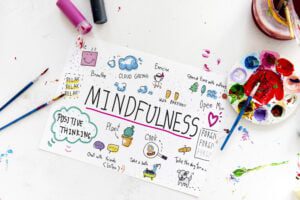Weaving Mindfulness
This article is all about mindfulness and how you can bring it into your everyday routines. Mindfulness means paying attention to what’s happening in the present moment, and it can help you feel calm and happy. The article will give you some ideas on how to be mindful when you’re doing things like eating, brushing your teeth, or even just walking. By being aware of your actions and the world around you, you can start to feel more connected and alive. So get ready to learn some simple techniques to weave mindfulness into your daily life!

Creating Mindful Morning Routines
Setting Intentions for the Day
To start your day off mindfully, it’s important to set intentions for the day ahead. This means taking a few moments each morning to think about what you hope to accomplish and how you want to feel throughout the day. You can set intentions for your work, relationships, and personal growth. By setting positive and mindful intentions, you are more likely to align your actions and thoughts with what truly matters to you.
Morning Meditation Practice
One of the most effective ways to cultivate mindfulness in the morning is through meditation. Meditation helps calm the mind and brings you into the present moment. Find a quiet and comfortable place to sit, close your eyes, and focus on your breath. Pay attention to the sensation of the breath entering and leaving your body. If your mind wanders, gently bring your focus back to the breath. Start with just a few minutes and gradually increase the duration as you become more comfortable with the practice.
Mindful Movement and Stretching
Incorporating mindful movement and stretching into your morning routine can help you connect with your body and bring awareness to your physical sensations. You can try yoga, gentle stretches, or even just some simple movements to wake up your body. As you move, pay attention to how each movement feels in your body and be present in the moment. This can help you start your day with a sense of physical and mental well-being.
Mindful Eating and Drinking
Another important aspect of a mindful morning routine is mindful eating and drinking. Take the time to enjoy your breakfast and savor each bite. Slow down and appreciate the flavors, textures, and smells of your food. Chew slowly and pay attention to the sensations in your mouth. Similarly, when drinking your morning beverage, such as tea or coffee, be present with each sip and notice the warmth and taste. This practice can help you cultivate gratitude for the nourishment your food and drink provide.
Gratitude Journaling
Ending your morning routine with gratitude journaling can help you start your day with a positive mindset. Take a few minutes to reflect on things you are grateful for and write them down in a journal. This can be as simple as appreciating the sun shining or the smile of a loved one. By focusing on the positive aspects of your life, you can set the tone for a mindful and joyful day ahead.
Practicing Mindfulness During Meals
Mindful Eating Techniques
When it comes to practicing mindfulness during meals, there are a few techniques you can try. One technique is called “the pause.” Before taking the first bite of your meal, take a moment to pause and take a deep breath. This helps you bring your awareness to the present moment and connect with your body’s hunger and fullness cues. Another technique is to eat slowly and chew each bite thoroughly. This allows you to fully experience the flavors and textures of your food.
Savoring the Flavors and Textures
Mindful eating also involves savoring the flavors and textures of your food. Engage all your senses as you eat, noticing the colors, smells, and tastes of your meal. Take your time to chew and fully experience each bite. This can help you feel more satisfied with your meal and prevent overeating.
Connecting with the Food’s Source
Another way to practice mindfulness during meals is to connect with the source of your food. Consider the journey your food has taken to reach your plate, from the farmers who grew it to the people who prepared it. Reflecting on this connection can foster a sense of gratitude and appreciation for the nourishment your food provides.
Mindful Cooking and Meal Preparation
Mindfulness can also be integrated into the process of cooking and preparing meals. Instead of rushing through these tasks, take the time to be fully present. Notice the colors, textures, and smells of the ingredients. Engage your senses as you chop, stir, and season. This can help you cultivate a deeper connection with your food and enhance the overall dining experience.

Mindful Communication with Others
Active Listening
Practicing mindfulness in your communication with others starts with active listening. When someone is speaking to you, give them your full attention and avoid thinking about what you’re going to say next. Instead, focus on truly hearing and understanding their words. Maintain eye contact, nod, and show that you are actively engaged in the conversation.
Non-Judgmental Speaking
Mindful communication also involves speaking in a non-judgmental manner. Instead of immediately jumping to conclusions or making assumptions, try to approach conversations with an open and curious mindset. Be aware of your own biases and prejudices, and strive to communicate with kindness and understanding.
Empathy and Compassion
Practicing empathy and compassion towards others is an integral part of mindful communication. Put yourself in the other person’s shoes and try to understand their perspective. Show genuine care and concern for their well-being. By approaching conversations with empathy and compassion, you can foster deeper connections and create a positive impact on the lives of others.
Mindful Conflict Resolution
Conflict is a natural part of human interactions, but practicing mindfulness can help navigate these situations with grace. When conflicts arise, take a step back and observe your emotions and reactions. Allow yourself to pause and take a few deep breaths before responding. By approaching conflict mindfully, you can communicate with clarity and find solutions that are fair and beneficial for all parties involved.
Mindfulness in the Workplace
Mindful Work Transitions
Transitioning mindfully between tasks or work-related activities can help improve focus and productivity. Before starting a new task, take a moment to pause and bring your attention to the present moment. Take a deep breath and mentally let go of any lingering thoughts from the previous task. By consciously shifting your focus, you can approach each new task with clarity and intention.
Pomodoro Technique for Focus
The Pomodoro Technique is a time management method that can be used to practice mindfulness in the workplace. Divide your work into focused blocks of time, typically 25 minutes, called “Pomodoros.” During each Pomodoro, work on a specific task without distractions. After each Pomodoro, take a short break to rest and recharge. This technique helps you stay present and maintain focus throughout the workday.
Mindful Email and Communication
Email and other forms of digital communication can easily become overwhelming and distracting. To practice mindfulness in your email and communication, set aside specific times throughout the day to check and respond to emails. Avoid constantly checking your inbox and instead focus on one task at a time. When composing emails, take the time to read and edit them mindfully, ensuring clear and effective communication.
Creating a Mindful Workspace
Your physical workspace can greatly impact your mindset and focus. Create a mindful workspace by decluttering and organizing your desk. Surround yourself with items that inspire and bring you joy. Consider incorporating elements of nature, such as plants or natural light, into your workspace. By cultivating a mindful environment, you can enhance your overall well-being and productivity.

Bringing Mindfulness to Physical Exercise
Mindful Walking and Running
Walking and running can be opportunities for mindfulness and self-reflection. While exercising, bring your attention to the movement of your body. Pay attention to the sensation of your feet hitting the ground, the rhythm of your breath, and the sights and sounds around you. Allow any thoughts or concerns to arise and pass without judgment, simply observing them as they come and go.
Breathing Techniques During Workouts
Incorporating conscious breathing techniques into your workouts can enhance your physical and mental well-being. During exercise, be aware of your breath and try to maintain a steady and deep breathing pattern. This can help calm the mind, increase oxygen intake, and improve overall performance.
Listening to Your Body’s Signals
Practicing mindfulness during physical exercise involves tuning in to your body’s signals and responding accordingly. Pay attention to any sensations of discomfort or pain and adjust your movements as needed. Also, be mindful of your energy levels and honor when your body needs rest or a more gentle workout. By listening to your body’s signals, you can practice exercise in a way that respects your limits and supports your overall well-being.
Mindful Yoga and Stretching
Yoga and stretching provide an opportunity for Weaving Mindfulness and deepening mind-body connection. During your practice, focus on the sensations in your body as you move through each pose or stretch. Be present with the breath and notice the subtle shifts in your body’s alignment. Allow yourself to fully experience each movement and find a sense of calm and presence in your practice.
Cultivating Weaving Mindfulness in Nature
Nature Immersion and Ecotherapy
Spending time in nature can be a powerful way to cultivate mindfulness and connect with the natural world. Take regular walks in nature, explore nearby parks, or simply sit outside and observe the beauty around you. Engage your senses and notice the colors, sounds, and smells of nature. This practice, also known as ecotherapy, can promote relaxation, reduce stress, and foster a deeper sense of connection with the Earth.
Mindful Observation of Natural Surroundings
When in nature, practice mindful observation by taking a few moments to simply observe your surroundings. Pay attention to the intricate details of plants, the movements of animals, or the sounds of flowing water. Allow yourself to become fully absorbed in the present moment, letting go of any distractions or preoccupations.
Mindful Gardening and Plant Care
Engaging in gardening or plant care can be a meditative and mindful practice. As you tend to your plants, focus on the sensations of the soil in your hands, the smell of the flowers, and the sounds of nature around you. Notice the growth and changes in your plants and connect with the life cycle of nature. Gardening can provide a sense of purpose, connection, and relaxation.
Connecting with the Earth’s Energy
Weaving Mindfulness in nature also involves connecting with the Earth’s energy. Take off your shoes and walk barefoot on grass or sand, feeling the connection between your bare feet and the Earth. Spend time sitting or lying on the ground, feeling the support of the Earth beneath you. This practice can help you feel grounded, centered, and connected to the larger web of life.
Weaving Mindfulness in Daily Chores and Housekeeping
Bringing Awareness to Cleaning Tasks
Everyday chores and housekeeping can be transformed into mindful activities by bringing awareness to your actions. Whether you’re washing dishes, sweeping the floor, or folding laundry, focus on the physical sensations and movements involved. Notice the temperature of the water, the texture of the surfaces, and the rhythm of your movements. By fully engaging in these tasks, you can find joy and peace in the simplest of actions.
Mindful Organizing and Decluttering
Organizing and decluttering your living space can contribute to a sense of calm and clarity. Approach these tasks mindfully by being fully present with each item you handle. Consider if each item brings you joy or serves a purpose in your life. Let go of anything that no longer serves you and create a space that supports your well-being.
Finding Joy in Simple Tasks
Weaving Mindfulness in daily chores involves finding joy in the simplicity of everyday tasks. Instead of viewing these tasks as burdens, cultivate a sense of gratitude for the opportunity to care for your home and yourself. Find beauty in the small moments, like the scent of freshly washed sheets or the comforting warmth of a clean and organized space.
Ritualizing Daily Chores
Incorporating Weaving Mindfulness rituals into your daily chores can enhance your overall well-being. For example, create a ritual of lighting a scented candle or playing calming music while doing the dishes. This can help create a sense of sacredness and presence in your daily activities. Find rituals that resonate with you and infuse mindfulness into your everyday routines.
Mindfulness in Technology Use
Setting Mindful Technology Boundaries
In today’s digital age, it’s important to create mindful boundaries with technology. Set specific periods of time each day where you disconnect from screens and engage in other activities. This could be reading a book, spending time in nature, or engaging in face-to-face conversations. By setting boundaries, you can prioritize mindful presence and reduce the distractions that technology can bring.
Mindful Social Media Engagement
When engaging with social media, be mindful of your emotions and reactions. Notice how certain posts or comments make you feel and take breaks if you find yourself becoming overwhelmed or stressed. Focus on cultivating positive, uplifting content in your social media feed and limit exposure to negativity or comparison. Use social media as a tool for connection and inspiration, rather than mindless scrolling.
Taking Digital Detox Breaks
Periodically taking digital detox breaks can be beneficial for your mental and emotional well-being. Dedicate a day or weekend to disconnecting from screens and engaging in activities that nourish your soul. Spend time outdoors, read a book, engage in creative hobbies, or simply enjoy quality time with loved ones. By taking regular breaks from technology, you can recharge, reconnect with yourself and others, and cultivate a deeper sense of presence.

Practicing Weaving Mindfulness in Self-Care
Mindful Bath and Shower Rituals
Self-care can be transformed into a Weaving Mindfulness practice by bringing awareness to your daily bathing routine. Whether you’re taking a bath or shower, focus on the sensations of the water on your skin, the scents of the soap or bath products, and the relaxing or refreshing nature of the experience. Turn off distractions, such as your phone, and create a quiet and peaceful space for self-care.
Self-Massage and Body Awareness
Incorporate self-massage into your self-care routine to cultivate mindfulness and body awareness. Use gentle circular motions to massage your face, neck, shoulders, and other areas of tension. Pay attention to the sensations in your body and notice any areas of tightness or discomfort. This practice can help release tension, increase circulation, and promote a sense of self-nurturing.
Mindful Skincare and Pampering
Take the time to care for your skin mindfully by using natural and nourishing products. Apply skincare products with intention, focusing on the textures, scents, and benefits they provide. Use this time to slow down, connect with your body, and give yourself the care and attention you deserve. Mindful skincare can contribute to a sense of self-love and well-being.
Nurturing Weaving Mindfulness Relationships with Yourself
Practicing Weaving Mindfulness in self-care also involves nurturing a mindful relationship with yourself. Take time each day to check in with yourself and ask how you’re feeling physically, emotionally, and mentally. Journaling, meditation, or simply sitting in quiet reflection can help you cultivate self-awareness and deepen your connection with yourself. Treat yourself with kindness, compassion, and acceptance, just as you would a dear friend.
Closing the Day with Mindfulness
Reflecting on the Day with Gratitude
As you close the day, take a few moments to reflect on the events and experiences of the day. Write down three things you are grateful for and reflect on the positive moments that brought you joy or made you feel grateful. By cultivating gratitude, you can shift your focus to the positive aspects of your life and promote a sense of contentment and well-being.
Before-Bed Relaxation Techniques
To promote restful sleep and relaxation, incorporate mindful relaxation techniques into your nighttime routine. This can involve activities such as gentle stretching, deep breathing exercises, or engaging in a calming hobby or reading. Create a peaceful and comfortable environment in your bedroom, free from distractions, and dedicate time to wind down before bed. By embracing mindful relaxation, you can prepare your mind and body for a restful night’s sleep.
Mindful Sleep Preparation
Weaving Mindfulness sleep preparation involves creating a sleep-friendly environment and establishing a nighttime routine that promotes relaxation. Create a calming bedtime ritual by dimming the lights, listening to soothing music, or practicing a few moments of mindful meditation. Avoid stimulating activities, such as working or using electronic devices, in the hour leading up to bedtime. By incorporating mindfulness into your sleep routine, you can set the stage for a night of rest and rejuvenation.
Incorporating mindfulness into your daily life can bring a sense of peace, presence, and well-being. By integrating mindful practices into various aspects of your routine, you can cultivate a deeper connection with yourself, others, and the natural world. Start small, be patient with yourself, and embrace the journey of living with awareness and intention.
Weaving Mindfulness
Exploring the intersection of weaving and mindfulness reveals unique approaches that combine the tactile pleasure of weaving with the mental benefits of mindfulness. Here are three comprehensive resources that delve into this fascinating synergy:
- Woven Flow: Weaving As Meditation (Handwoven Magazine)
- This resource provides an insightful look into how the rhythmic and engaging process of weaving can foster a meditative state, often referred to as “flow.” It explores the mental health benefits and the profound sense of calm and focus that can be achieved through a consistent weaving practice. The article highlights personal stories and experiences, underscoring the therapeutic potential of weaving in managing conditions such as anxiety, depression, and ADHD. It also offers practical advice on how to maximize the mental health benefits of weaving, including the importance of consistency, intention, and method in your practice.
- URL: Handwoven Magazine
- Mindfulness & Well-Being Weaving for Beginners (The Loom Room)
- The Loom Room offers a unique approach to weaving as a method for improving well-being and mental health. It emphasizes the therapeutic aspects of weaving, positioning it as a go-to strategy for centering oneself and navigating emotions of panic, grief, and overwhelm. The Loom Room provides practical strategies for engaging in weaving to promote mental health and equilibrium, offering both in-person and online learning opportunities for those interested in exploring weaving as a meditative practice.
- URL: The Loom Room France
- Sit Spots: Weaving Mindfulness and Nature Together (Powerful Learning)
- This resource introduces the concept of “Sit Spots” as a way to weave mindfulness and nature together. It explains how establishing a personal spot in nature for regular visits can deepen one’s connection to the natural world and enhance mindfulness. The practice encourages observation, presence, and a sense of peace by connecting with the surrounding environment. This approach is particularly beneficial for educators looking to incorporate mindfulness and nature into their teaching practices.
- URL: Powerful Learning
Each of these resources provides a unique perspective on the benefits of combining weaving with mindfulness, offering both theoretical insights and practical guidance for those interested in exploring this synergistic practice.
